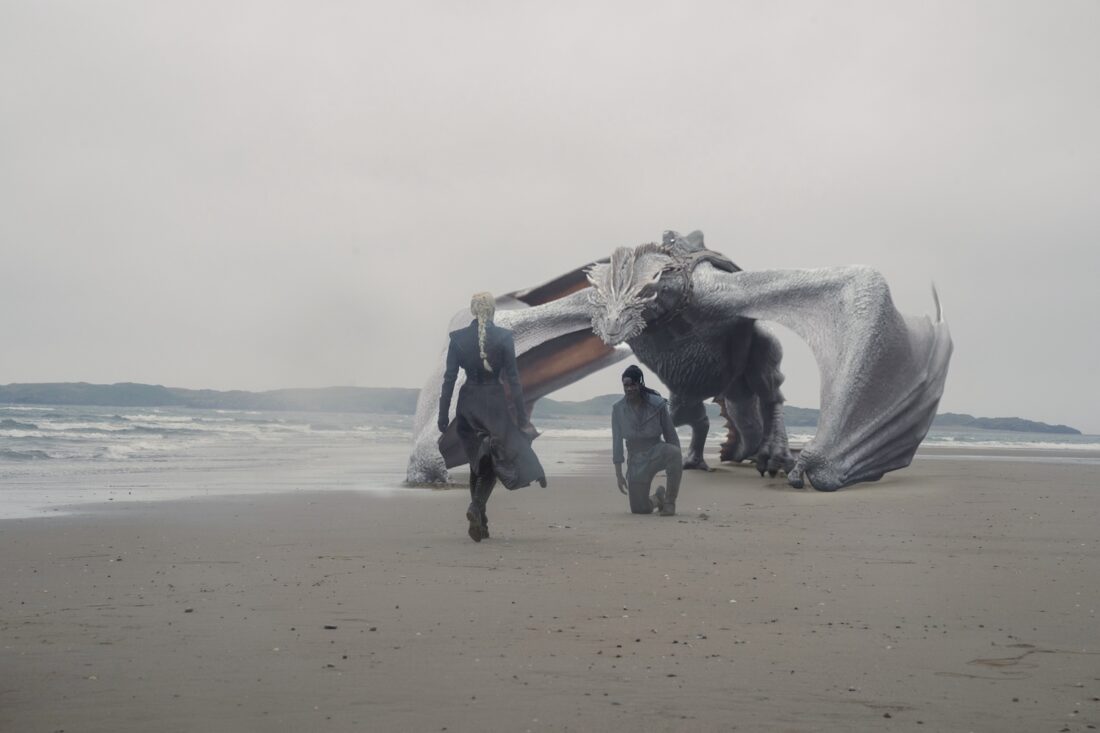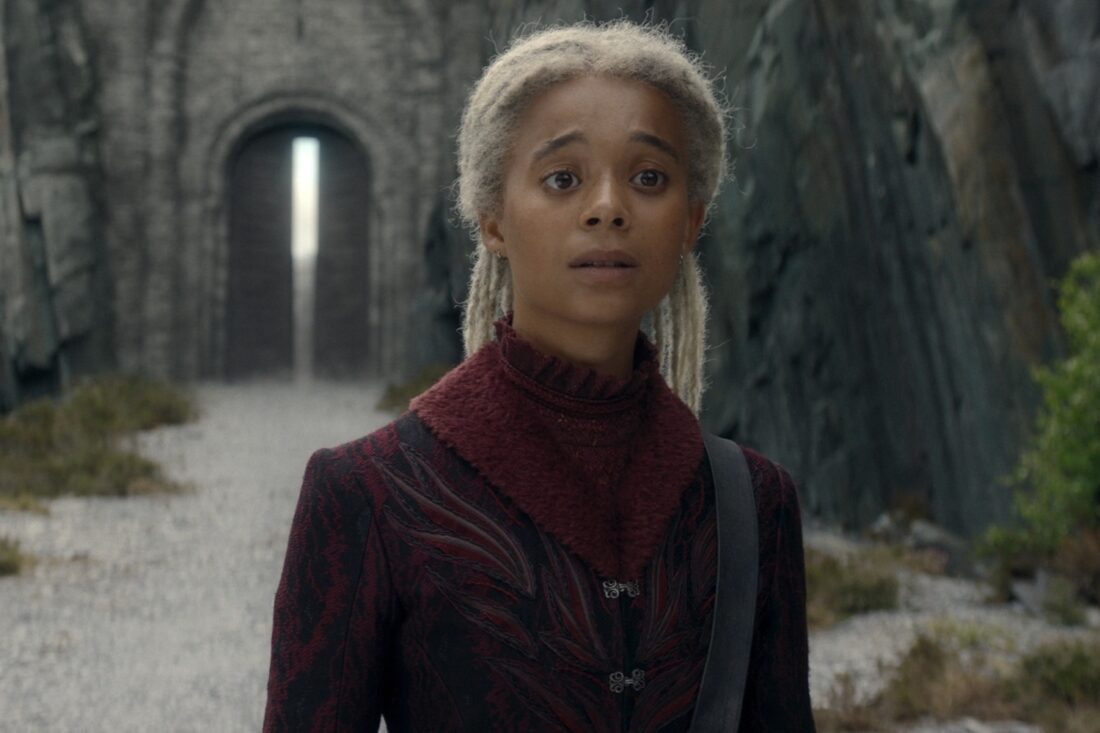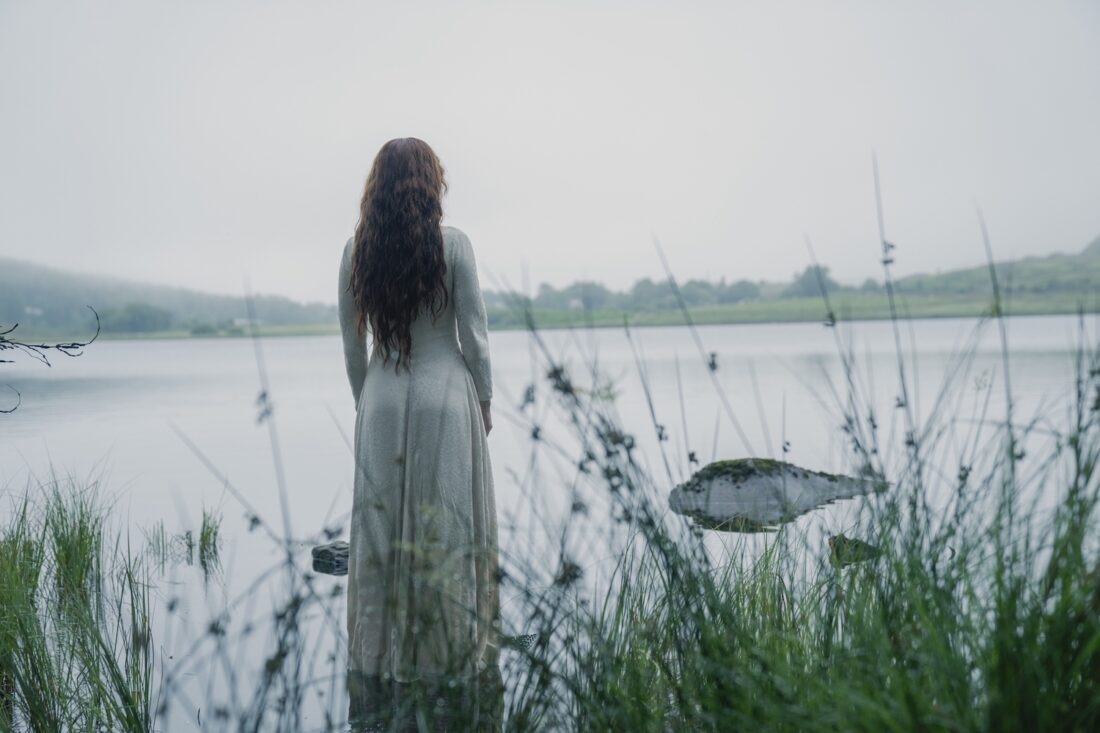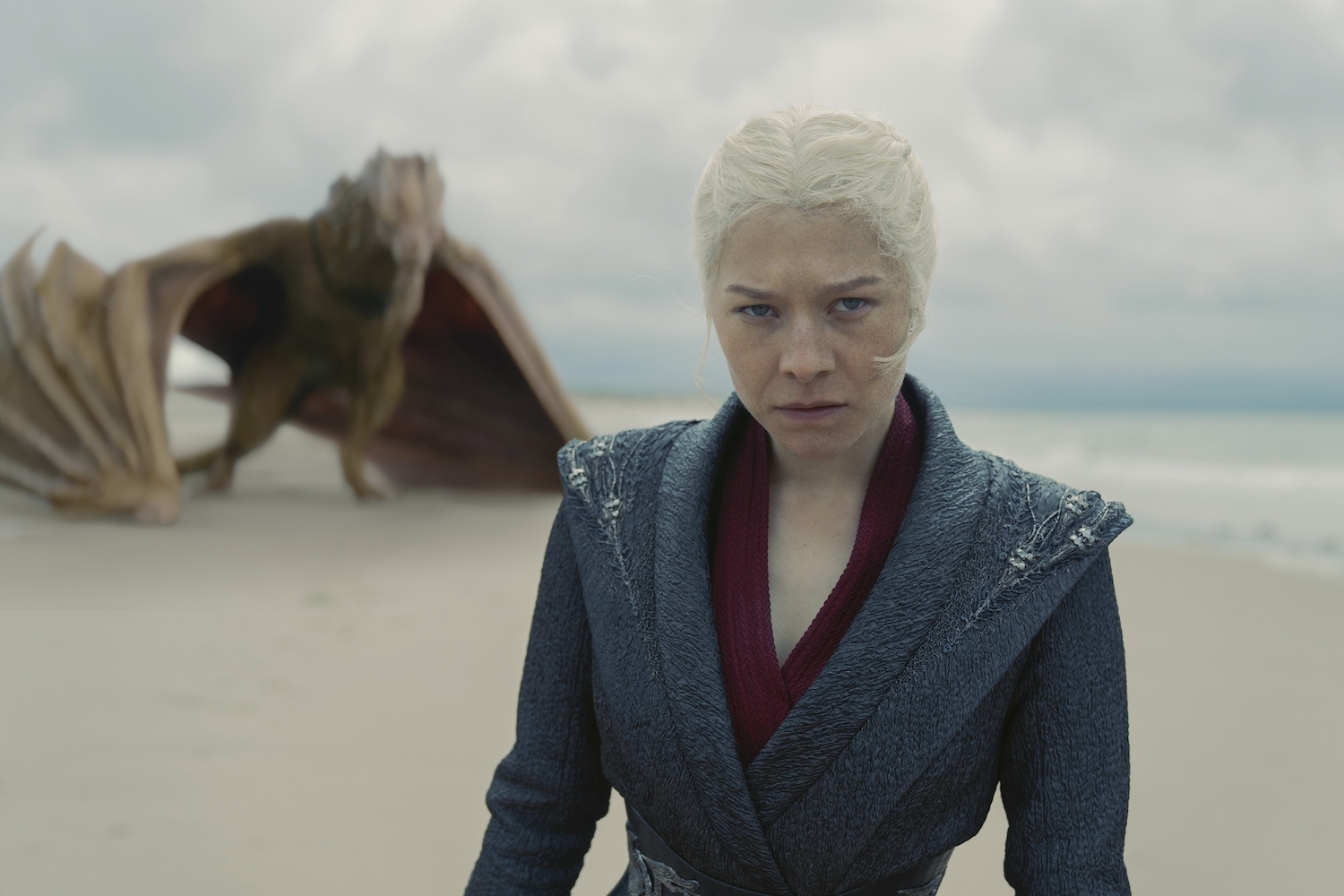This penultimate episode of season 2 gives us the rest of the Sowing of the Seeds and finally lets non-book readers in on why we’ve been following Hugh and Ulf all season. It brings Daemon’s plot in the Riverlands to a close while bringing us to a cliffhanger moment in his personal journey. It also features some of the most gorgeous photography in the entirety of the show as Alicent spends a few days reconnecting with nature. We’ll talk about the specifics of this episode’s increasingly thorny class politics, the new dragons on the scene, and some content cut from Fire & Blood that it’s (probably) safe to talk about now. Spoilers for the episode and some book-related speculation below…
The Title
The title of this episode is “The Red Sowing,” which is the cacophomism for “the Sowing of the Seeds”—the incident where Seasmoke, Vermithor, and Silverwing were claimed by dragonseeds. While “the Red Sowing” is a phrase known to people of the Seven Kingdoms, using that term (rather than “the Sowing of the Seeds” or simply “The Sowing”) moves away from the show’s typical ethos of using more flowery names that reflect a sanitized or heavily biased version of the bloody history. The Red Sowing is a moment of triumph for Rhaenyra but it comes at the cost of the slaughter and burning of dozens of people. In the “Inside the Episode” interviews, Ryan Condal even refers to it as a “ritual sacrifice.”
Dragonseed Lineages and Dragonkeeper Politics
We’re seeing some interesting reactions to the ways in which the show has added nuance and new details to its version of the Sowing of the Seeds. First off, we witness the rise of the crisis that was hinted at in last week’s episode, where allowing lowborn dragonseeds to ride dragons is considered a perversion of the art of dragonriding.
F&B gives us a few pages on the “Sowing of the Seeds” or the “Red Sowing.” In the books, while the Targaryen bastards are front and center, there it’s much more of a free-for-all, with anyone loyal to the Blacks invited to participate.
Munkun’s True Telling tells us that sixteen men lost their lives during the Sowing. Three times that number were burned or maimed. Steffon Darklyn was burned to death whilst attempting to mount the dragon Seasmoke. Lord Gormon Massey suffered the same fate when approaching Vermithor. […] Vermithor, the Old King’s own dragon, bent his neck to a blacksmith’s bastard, a towering man called Hugh the Hammer or Hard Hugh, whilst a pale-haired man-at-arms named Ulf the White (for his hair) or Ulf the Sot (for his drinking) mounted Silverwing […] and Seasmoke, who had once borne Laenor Velaryon, took onto his back a boy of ten-and-five known as Addam of Hull.
(Fire & Blood, 441-442)
The show opts, instead, to portray the inclusion of the Targaryen bastards as causing a scandal. There has been a strong throughline this season of the general classism of both the Greens and the Blacks this season and this is one point where it culminates in a meaningful way.
Part of this comes from the way in which the show has reimagined the dragonkeepers. In F&B, the order is founded in 56 AC after Aerea Targaryen returned from her disastrous two-year sojourn with Balerion (you can read my article on Martin and horror for the specifics of that sad chapter). They are a special order of trained guards and handlers, but they are not an esoteric order full of Valyrian mysticism. In HotD, the dragonkeepers appear to be as old as the Targaryens themselves. They wear Valyrian colors (their robes are the same red and yellow designs that Rhaenyra and Daemon wear at their traditional Valyrian wedding). They only ever speak in High Valyrian and seem to share some Old Valyrian sensibilities. They refer to Steffon Darklyn as an “Andal” (the ethnic group from Western Essos that dominates the Southern Westerosi houses) reminding the audience that he is, from their perspective, part of an outgroup (incidentally, the Darklyns are generally thought of as being descended from the First Men in AsoIaF).
I was initially surprised that the show chose to represent the dragonkeepers as being anti-bastard—isn’t a Targaryen a Targaryen? But it makes sense if they are not just an order of dragon experts but true remnants of Valyrian culture. The Freehold of Valyria was a slave state and, even before the Doom, there was a premium placed on the precious rarity of dragonlord blood. Lowborn bastards are, therefore, only to be used for sacrifice. We may find the Westerosi nobility’s class politics to be abhorrent but they are still better than those held by the Valyrians.
In terms of Targaryen lineages, Hugh (Kieran Bew) gets a weirdly truncated acknowledgement of his status as a dragonseed this episode. It does strike me as a little bit rushed that we spent six episodes establishing his backstory and domestic life only to have his daughter die off-screen and the reveal of his Targaryen bastardy occur in a scene immediately before he becomes plot-relevant. The other potential dragonseeds, Addam of Hull (Clinton Liberty) and Ulf the White (Tom Bennett) had comparatively much better-paced arcs leading up to the pivotal moment. That said, in the book, we get no specific lineage for Hugh other than that he is the bastard son of a blacksmith claiming Targaryen heritage. The show’s version of Hugh says that he is the son of a Targaryen sex worker. That would make his mother, most likely, Saera Targaryen, the ninth-born child of Jaehaerys (Michael Carter) and Good Queen Alysanne, and the aunt of Viserys and Daemon.
In F&B, Saera is plagued by scandal for her premarital sexual interests, which only escalate as King Jaehaerys attempts to punish the princess for her behavior. The end result is that, after being forced to take a septa’s vows, she flees to Lys and becomes a sex worker. She later returns to Westeros in middle age as a powerful madame who presses the claims of her sons with the Triarch of Lys at Jaehaerys’ Great Council of 101. Obviously, HotD has cut that part of it (and it may well be that Hugh’s mother is someone other than Saera) but it’s great to see a real lineage given to the character.
DragonWatch

This was one of the dragon-heaviest episodes of the series so far, with Syrax and Seasmoke both making appearances, as well as the introduction of two new dragons (give or take a single shot of a Vermithor last season). That means that about two thirds of the dragons mentioned in F&B have made it to the screen so far…
Syrax — Syrax is among the most regularly featured dragons on the show and has been spectacularly displayed in each of her appearances, starting with the very first episode. We haven’t seen much of her so far this season, so yesterday’s episode gave us a decent look at the Black Queen’s mount. Syrax has only ever been ridden by Rhaenyra and it’s implied that she is one of the dragons who bonded with their first rider from the egg—with Rhaenyra first riding her at age seven. We don’t have an exact date of birth but the evidence implies that she’s near Rhaenyra’s age. Syrax, like Meraxes, Vhagar, and Balerion, is the name of an Old Valyrian god though, as with the entire Valyrian pantheon, we only know the name and have never gotten a canon explanation of their domain/characteristics.
F&B describes Syrax as huge and yellow-scaled though not as large or formidable as Caraxes. The show has depicted Syrax as one of the smaller rideable dragons on the show—roughly the same size as Seasmoke. She retains her yellow scales and has been given a somewhat gentle aspect. She’s not quite as doglike as Sunfyre, but her external lips hide her teeth entirely and she has a quartet of long, scaled back curving horns that are not as fearsome as those of other dragons. Her fins are less spiky and her features are smoother. She is not battle-tested and, according to F&B, she was made more docile by years of being chained in the Dragonpit and hand-fed rather than being allowed to hunt.
Vermithor — We have technically seen Vermithor in the finale of season one, in the scene where Daemon sings his lullaby deep in the bowels of the Dragonmont. He’s called “the Bronze Fury,” as Rhaenyra says, and is the second oldest and second largest tame dragon in Westeros. Vermithor was hatched in King Jaehaerys’ crib in 34 AC, making him currently 96 years old (note that he’s still only half the age of Vhagar). I’ve mentioned this factoid before, but the name “Vermithor” likely comes from Vermithrax Pejorative (the dragon in the absurdly dark 1981 fantasy film, Dragonslayer, who is George R.R. Martin’s favorite on-screen dragon). In-world, the name sounds Valyrian but we have no explanation for what it might mean. The book describes him as bronze-scaled with tan wings, which the show has kept to fairly accurately. They’ve given him a bit of the aging dragon iguana-wattle that Vhagar has, as well as horns along his chin that give him a little bit of a bearded look. Like his elderly aunt, he’s kaiju-coded, and the show chooses to introduce him in a truly terrifying extended scene that highlights his slow, almost lackadaisical murder of a dozen dragonseeds. It captured some of the dread majesty of the T-Rex scenes in Jurassic Park. That is enhanced by the forward-curving horns that make his face look a little like a Carnotaurus. Despite his fierceness, Vermithor has no actual battle experience, though his first rider, Jaehaerys the Conciliator, did use him as a threat to his enemies.
Silverwing — Silverwing is one of the very few dragons left on the show that we have not previously seen in any form (save for on a stamp, the image of which was leaked ahead of this episode). She is the next oldest dragon after Vermithor, being somewhere between 96 and 88 years old. She’s named for her coloration though High Valyrian conlinguist David J. Peterson has said that her name (meaning, roughly “Silverwing”) in the mother tongue is Gēliotīkun. Obviously silvery in color, in line with her book description, Silverwing’s advanced age is portrayed somewhat differently than that of Vhagar and Vermithor. She looks emaciated and drawn—almost skeletal. Her neck, though proportionally shorter than Caraxes’ is still long and snakelike, and they’ve given her a fan of fins at the end of a long, whiplike tail that looks almost like a flanged mace. It’s a lean and dangerous look that is fascinatingly at odds with what Gyldayn describes as her docile, friendly nature. Her previous rider was Jaehaerys’ beloved wife, Good Queen Alysanne, who is perhaps the single most beloved Targaryen in the entire dynastic history. Like Alysanne herself, Silverwing is famously charismatic and regal—a dragon to be loved rather than feared. It’s an interesting juxtaposition that Silverwing is now paired with the feckless Ulf, whose charms are of a crasser and baser variety. Like Vermithor, she is not battle-tested, but she has been to the Wall (where she famously refused to cross it) and is a beloved symbol of authority, especially in the North.
Some Erasures

(Potential Show Spoilers Ahead)
This section contains some speculation on things that I am assuming have been cut from the show. That said, it is possible that some of these elements have simply been moved to later points in the series or may be repurposed. Be forewarned that by reading this section, you might spoil yourself for future plot points that could potentially show up in season 3. It will be safe to resume reading in the “Odds & Ends” section, if you want to skip ahead!
There is a moment when the Kings Landing dragonseeds are boarding the ships to Dragonstone where we see a young peasant girl with dark skin and textured hair. She may or may not be intended to evoke Nettles, a character that the show appears to have cut in order to give her plot to Rhaena Targaryen. I did check, though, and we do not specifically see that extra die during the sequence with Vermithor. There has been a lot of discussion (and general disappointment) over Nettles being cut from the show. She’s the only canonical person of color in the Dance of the Dragons, a shepherd whose eventual bond with the feral dragon, Sheepstealer, puts the “dragonriders must be dragonlords” shtick into the most doubt—she is assumed to be a dragonseed but has no Targaryen features or a lineage that can be traced back to any specific Targaryen. In some ways, giving her plot to Rhaena makes sense. Rhaena is a member of the main cast and is important later on in the Dance but has relatively little to do during the first two seasons of the show. Allowing her to pursue Sheepstealer (that has to be why we see all the sheep corpses) makes some sense. Rhaena is being characterized as somewhat temperamentally similar to the Nettles of the book, and given the casting of so many other actors of color on HotD, cutting the one woman of color from the book (or at least repurposing her plot) isn’t as egregious as it might have been.
But there is plot with Nettles later in F&B that can’t be transferred to Rhaena. Namely, she has an affair with Daemon (who, I should remind you, is Rhaena’s father) and eventually she flees the court of the Blacks on dragonback in order to live as a reclusive “fire witch” in the Vale. That feels like something the show will not do with Rhaena. It’s possible that, given how much of a character arc Daemon has been given this season and how much they have transferred some of the sexual tension Alys Rivers (Gayle Rankin) has with another character in original book to Matt Smith, it may simply be that Daemon’s eventual affair with Nettles doesn’t make as much plot sense as it does in the book. With both Sheepstealer and the affair taken care of elsewhere, Nettles might not be as centrally important to HotD as she is in the source material.
Additionally, in moving the plot with Sheepstealer to Rhaena in the Vale, the show might be cutting three further dragons from its roster. In F&B, in addition to Seasmoke, Vermithor, and Silverwing, the Dragonmont is also home to three feral dragons, i.e. dragons who have reached adulthood and never been bonded to a rider. They have no official names but the smallfolk of Dragonstone have nicknamed them Sheepstealer (for their hunting habits), Grey Ghost (for their coloration and stealthy nature), and the Cannibal (for its unsavory habit of eating dragon eggs and other hatchlings). While Grey Ghost and the Cannibal are never ridden in the books, they are a neat plot point and, call me crazy, but I think the dragon show should have as many dragons as possible. In pairing up Rhaena with Sheepstealer, the show is potentially cutting the dragon hatchling she eventually bonds with in the book, who is called Morning. So that’s three dragons potentially dispensed with one adaptation change.
It is possible that Nettles may show up in season three, perhaps even riding Grey Ghost or the Cannibal. But, if she does, the character will likely be greatly altered from her role in the book, and it may just be that the show isn’t interested in adding someone so very new whose major plot points have already been covered elsewhere.
Odds & Ends

- After the death of Leon Estermont (Ralph Davis) during the food riots last episode, Aemond pins the blame for the riots on Aegon’s remaining drinking buddies turned Kingsguard, Ser Eddard Waters (Tok Stephens) and Ser Martyn Reyne (Barney Fishwick), forcing them to take the black.
- We finally get confirmation in this episode that Antonio Magro is playing Lord Petyr Piper this season. He’s only identified as “Lord Piper” on IMDb for obvious reasons. Adapting F&B for television means consistently grappling with the nonchalance with which Martin deploys a silly character name for someone that gets mentioned twice on the page, only for HotD to have to write around their goofy name or avoid having it mentioned on screen.
- Lord Piper’s men-at-arms wear the house sigil, with its dancing nude woman draped in a white banner—I believe this is the first time any GoT show has shown it. The sigil takes its name for the seat of House Piper—Pinkmaiden—whose curious nomenclature has never been fully explained. The house seems to use the azure of the sigil’s field as their primary color.
- You can see members of House Vance of Atranta (with their black dragon quartered with yellow eye sigils) during Oscar Tully’s (Archie Barnes) address to the Riverlords. I believe this is another first for the series. Both branches of House Vance are named for seminal science fiction author Jack Vance, one of Martin’s heroes. The sigils of the two houses refer to his texts, The Dragon Masters (1962), The Eyes of the Overworld (1966), and Liane the Wayfarer (1950)—the other branch of House Vance is from “Wayfarer’s Rest.”
- Ser Simon Strong’s (Simon Russell Beale) robe is so close in both hue and pattern to one of George Martin’s iconic looks that I’m thoroughly convinced of the conscious styling choice I suggested last week.
- I have once again been proven wrong about what the show is doing with Willem Blackwood (Jack Parry-Jones) and Oscar Tully. It seems that Oscar will be a partial replacement for the Benjicot Blackwood child soldier plot.
- Another small complaint along the same lines as Aegon and Rhaenyra being named as rulers of the Rhoynar; this episode suggests that Steffon Darklyn (Anthony Flanagan) was both Lord Commander of the Queensguard and heir to the Dun Fort. Joining the Kingsguard (or the Night’s Watch, or the order of Maesters) requires that you give up any claim to lands or titles (along with taking a vow of celibacy that ensures there are no descendants to press a claim). That was the whole conflict between Tywin and Jaime in the original series—Tyrion had to be heir to Casterly Rock as long as Jaime was in the Kingsguard. So Ser Steffon can’t have been heir to the Dun Fort.
- It’s been subtle, but one of the ways in which the show has been reinforcing Jace’s lack of trust in Rhaenyra lies in the detail that he believes that his bastardy makes him illegitimate. In Westeros, a monarch or Lord can legitimize their bastard child. Even if Jace is not a Velaryon, he is still the son of the Targaryen queen. For him to believe that his father being Harwin Strong disqualifies his inheritance, he would have to believe that only his father’s lineage matters. It’s a quiet rebuke of the idea that a ruling Queen would be afforded all the same privileges as a King.
- In F&B, Alyn of Hull (Abubakar Salim) attempts to claim Sheepstealer and gives up on dragonriding after being badly burned. I assume that his invocation as being salt and sea in this episode is proof that he is more like his father and also that he will not attempt to claim a dragon on HotD.
- It’s a little weird that Elinda Massey (Jordon Stevens) wears the brightest red cloak and her House sigil while undercover in King’s Landing.
- Tom Bennett’s performance as Ulf has a particularly Ricky Gervais-style shiftlessness in this episode. It’s a good touchstone for our gladhanding, cowardly dragonseed.
- You’ll note that Gormon Massey (James Dreyfus), Rhaenyra’s most addled small council member, is still alive after the Sowing of the Seeds. It will be interesting to see if the show has some other fate in store for him or if he’ll continue to be an amusing if unremarkable presence now that his book-equivalent is dead in the source material.
- There is so much beautiful Pre-Raphaelite imagery featuring Olivia Cooke in this episode. Obviously, they were trying to fake us out a little bit with the potential drowning and its Pre-Raphaelite Ophelia parallels. All I can say is they better not. I think Alicent has a perfect endpoint in Fire & Blood and I would hate to see it changed without a truly earned expansion of her plot. But we can rejoice—Alicent is simply swimming peacefully in the waters of the Kingswood!
- In Season 1, episode 4 of the original Game of Thrones, that show’s Viserys Targaryen (Harry Lloyd) tells Doreah that one of the dragons whose skulls were in the Red Keep was Vermithrax. Benioff and Weiss put the name in as a reference to Martin’s beloved Dragonslayer and it is likely that the inclusion sparked Martin naming two of his historical dragons Vermithor and Vermax.
- Robert Rhodes, who plays the first burned dragonseed with the facial difference, is credited in this episode as “Silver Denys” a named dragonseed from F&B who is killed by the yet-unseen Cannibal. I assume he had some cut lines this episode since a featured extra usually doesn’t get end-credit billing. There is similarly a credit for Parker Lapaine, the dragonseed that Hugh saves from Vermithor
- According to the matching episode of HBO’s “The House that Dragons Built,” the face on Harrenhal’s Weirwood tree is George R.R. Martin’s.
In Conclusion
Despite what might have been cut out by the HotD showrunners, I think the show is better than ever. I’ll be interested in seeing what the endpoint of this season is in the finale next episode, seeing as both of my predictions for the season’s climax both seem unlikely at this point. But what did you think? Are you on board for our new dragonriders and our new dragons? Do you have any predictions for next week’s finale?
